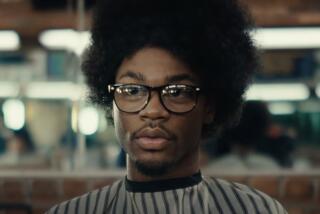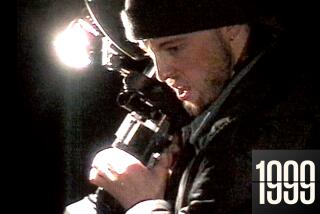Online Entertainment Blurs the Line of Art and Advertising
- Share via
In the opening scene of the short film “The Kiss,” the camera slowly pans up the blacktop to reveal actor Bernard Zilinskas sunning himself bare-chested on the hood of his car.
Buff young Zilinskas may have the lead role, but it was the car that got the film green-lighted. That’s because the film was approved and financed by Ford Motor Co., and the car, not coincidentally, is a Ford Focus.
Blurring the line between commerce and art, Ford and other advertisers are taking the concepts of product placement and sponsorship to the next level. They’re picking up the tab for online entertainment projects, hoping to absorb some of the coolness of the Web by association.
Unlike infomercials, projects such as “The Kiss” aim to be legitimate entertainment. But they also assure the sponsors that their wares are presented in a friendly, noncommercial light--a more subliminal approach than, say, putting a giant FedEx jet on screen.
It’s a throwback to the early days of TV, when consumer brands such as Texaco, Philip Morris and General Electric sponsored prime-time programs. But it’s also an acknowledgment that conventional marketing techniques, such as banner ads and buttons, don’t seem to be getting through to consumers on the Web.
Advertisers also are increasingly threatened by new TV recording devices that all but eradicate the 30-second spot. The pressure is on to weave their brands and products more closely to the entertainment so viewers can’t help but get the message.
A good example is an advertising campaign that Ford is conducting for its Focus cars on AtomFilms, a leading online film site. Ford funded and helped pick the scripts and directors for three short movies, each of which features a Focus.
Another example is a promotion on IFilm, “I Shot the Band,” which is financed by auto maker Mitsubishi Motors Corp. A movie by a yet-to-be-determined filmmaker will focus on a band’s experiences on tour, using a Mitsubishi truck filled with digital cameras and editing equipment provided by the sponsor.
Michael Kamins, associate professor of marketing at USC’s Marshall School of Business, said the strategy works only to the extent that the movies are entertaining and the products live up to the Web site’s image.
“These [viewers] are younger kids; I would bet they’re not as cynical toward advertising,” Kamins said. “So maybe they’re more accepting on the face of it because it’s not an ad. . . . It’s truly product placement, but it’s a sneaky way of seducing the audience.”
But Eric Dahlquist Sr., president of the Entertainment Resources and Marketing Assn., said the audience for online entertainment is too small for many companies to follow the two auto makers’ lead.
“I know people have done deals to do that, and it could be a new area of involvement, but I think the exposure’s too low, at least for most companies,” he said.
On the other hand, the Web is far more affordable than other mass media. Don Meek, senior vice president of sales for IFilm, said it would cost Mitsubishi more to run a 30-second ad during “Friends” on NBC than it will to produce “I Shot the Band.”
Seth Levenson, vice president of sales for AtomFilms, agreed. Ford’s budget for each of the three movies was in the tens of thousands of dollars, not hundreds of thousands, he said.
Bill George, a Ford spokesman, said his company’s goal is “to be in different, unexpected places where the younger consumers are,” such as AtomFilms’ Web site. He added, “We want to be more a part of their lives than just kind of bang them over their heads with 30-second spots.”
Although Ford helped choose the scripts and made comments on rough cuts of the movies, Rob Donnell, creative director at the J. Walter Thompson advertising agency, emphasized that the company wasn’t looking for an overt pitch for Ford cars.
“We had to be very careful to make sure they were entertaining,” Donnell said. “There was no gratuitous use of the vehicle.”
Levenson said Ford gave minimal direction to the filmmakers. “They said, ‘Do whatever you want, but you’ve got to have the car in there somehow,’ ” he said.
Five filmmakers were competing for the three slots financed by Ford, however, providing a not-so-subtle incentive to curry Ford’s favor. And in two of the films--”The Kiss” and “Little Man on Campus”--the car plays an integral role as a babe magnet.
In “Little Man,” for example, a diminutive high school student played by Adam Weisman first attracts the head cheerleader, played by Kari Lynn Casey, when she sees him washing his family’s Focus. “Nice car,” she says, and soon invites him home to hang out.
Morgan Lawley of Los Angeles, who wrote and directed “Little Man,” said she didn’t feel any pressure to show off the Focus in order to get funding.
The film started with the idea of a kid who was too short to make the football team. His father offers to give him a car if he can make the team, Lawley said.
“I wasn’t trying to do a hard sell at all,” she said. “My goal was, if someone watched the movie and didn’t know Ford sponsored it . . . they would just think that that was the car that the dad had.”
Most of the 59 AtomFilms viewers who rated “Little Man” gave it high marks, although four wondered whether it was a commercial or a film.
The other films also drew a few criticisms for being too promotional, although it’s an open question whether viewers would have known of Ford’s sponsorship if the Web site hadn’t told them.
Mitsubishi has no guarantee that its products will wind up in “I Shot the Band.” But George Penner, director of the interactive arm of the Deutsch Inc. advertising agency, noted that the filmmaker will be touring in a Mitsubishi Montero Sport, “and hopefully that will get translated and extended into their work.”
The goal is to drive home the message that Mitsubishi is “a hip company,” Penner said. And by running the campaign through IFilm and its advertising partners, Mitsubishi hopes to deliver that message subtly to both segments of the site’s core audience--young film viewers and filmmakers.
IFilms’ Meek said sponsors are viewed in a fundamentally different way from conventional advertisers. Sponsors are seen as supporting lifestyle decisions, Meek said, while advertisers intrude on them.
For Mitsubishi, he said, “This is clearly a lab for them to figure out what things work and don’t work.” He added that the filmmaker ultimately chosen for the project won’t have the auto maker hovering over his or her shoulder.
More to Read
The biggest entertainment stories
Get our big stories about Hollywood, film, television, music, arts, culture and more right in your inbox as soon as they publish.
You may occasionally receive promotional content from the Los Angeles Times.











